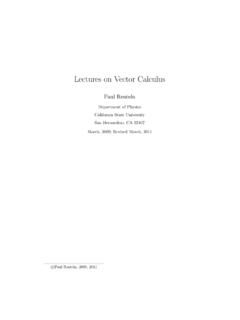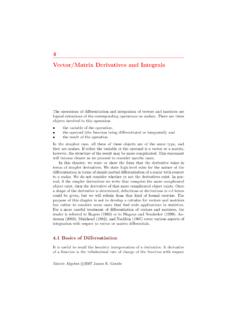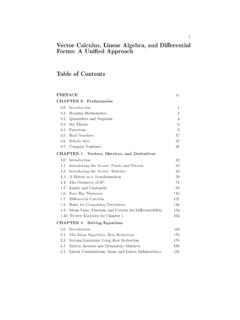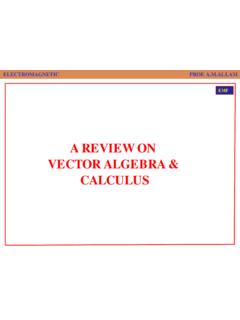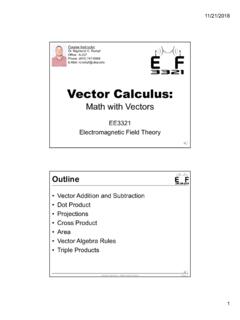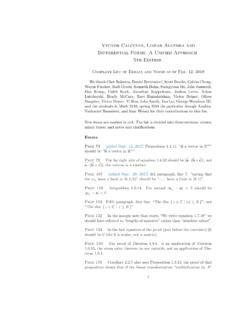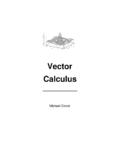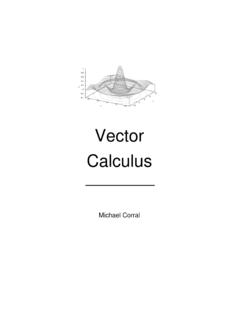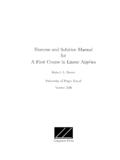Transcription of Lectures on Vector Calculus - Department of Physics
1 Lectures on Vector CalculusPaul RentelnDepartment of PhysicsCalifornia State UniversitySan Bernardino, CA 92407 March, 2009; Revised March, 2011c Paul Renteln, 2009, 2011iiContents1 Vector algebra and Index Orthonormality and the Kronecker Delta .. Vector Components and Dummy Indices .. Vector algebra I: Dot Product .. The Einstein Summation Convention .. Dot Products and Lengths .. Dot Products and Angles .. Angles, Rotations, and Matrices .. Vector algebra II: Cross Products and the Levi Civita Symbol Products of Epsilon Symbols.
2 Determinants and Epsilon Symbols .. Vector algebra III: Tensor Product .. Problems .. 312 Vector Calculus Fields .. The Gradient .. Lagrange Multipliers .. The Divergence .. The Laplacian .. The Curl .. Vector Calculus with Indices .. Problems .. 473 Vector Calculus II: Other Coordinate Change of Variables from Cartesian to Spherical Polar .. Vector Fields and Derivations .. Derivatives of Unit Vectors .. Vector Components in a Non-Cartesian Basis.
3 Vector Operators in Spherical Coordinates .. Problems .. 574 Vector Calculus III: Line Integrals .. Surface Integrals .. Volume Integrals .. Problems .. 695 Integral Green s Theorem .. Stokes Theorem .. Gauss Theorem .. The Generalized Stokes Theorem .. Problems .. 75A Permutations76B The Determinant as a Multilinear Map .. Cofactors and the Adjugate .. The Determinant as Multiplicative Homomorphism .. Cramer s Rule .. 89ivList of Figures1 Activeversuspassive rotations in the plane.
4 132 Two vectors spanning a parallelogram .. 203 Three vectors spanning a parallelepiped .. 204 Reflection through a plane .. 315An observer moving along a curve through a scalar field .. 336 Some level surfaces of a scalar field .. 357 Gradients and level surfaces .. 368A hyperbola meets some level surfaces ofd.. 379 Spherical polar coordinates and corresponding unit vectors .. 4910A parameterized surface .. 65v1 Vector algebra and Index Orthonormality and the Kronecker DeltaWe begin with three dimensional Euclidean spaceR3.
5 InR3we can definethree special coordinate vectors e1, e2, and choose these vectors tobeorthonormal, which is to say, both orthogonal and normalized (to unity).We may express these conditions mathematically by means of thedot productorscalar productas follows: e1 e2= e2 e1= 0 e2 e3= e3 e2= 0(orthogonality)( ) e1 e3= e3 e1= 0and e1 e1= e2 e2= e3 e3= 1(normalization).( )To save writing, we will abbreviate these equations usingdummy indicesinstead. (They are called indices because they index something, and theyare called dummy because the exact letter used is irrelevant.)
6 In indexnotation, then, I claim that the conditions ( ) and ( ) may be written ei ej= ij.( )How are we to understand this equation? Well, for starters, this equationis really nine equations rolled into one! The indexican assume the values 1,2, or 3, so we say iruns from 1 to 3 , and similarly equation is1 These vectors are also denoted , , and k, or x, yand z. We will use all threenotations for all possible choices of values for the , if we pick,say,i= 1 andj= 2, ( ) would read e1 e2= 12.( )Or, if we chosei= 3 andj= 1, ( ) would read e3 e1= 31.
7 ( )Clearly, then, asiandjeach run from 1 to 3, there are nine possible choicesfor the values of the index pairiandjon each side, hence nine object on the right hand side of ( ) is called theKronecker is defined as follows: ij= 1 ifi=j,0 otherwise.( )The Kronecker delta assumes nine possible values, depending on thechoices foriandj. For example, ifi= 1 andj= 2 we have 12= 0,becauseiandjare not equal. Ifi= 2 andj= 2, then we get 22= 1, andso on. A convenient way of remembering the definition ( ) is to imaginethe Kronecker delta as a 3 by 3 matrix, where the first index represents therow number and the second index represents the column number.
8 Then wecould write (abusing notation slightly) ij= 1 0 00 1 00 0 1 .( )2 Finally, then, we can understand Equation ( ): it is just a shorthandway of writing the nine equations ( ) and ( ). For example, if we choosei= 2 andj= 3 in ( ), we get e2 e3= 0,( )(because 23= 0 by definition of the Kronecker delta). This is just one ofthe equations in ( ). Lettingiandjrun from 1 to 3, we get all the nineorthornormality conditions on the basis vectors e1, e2and is easy to see from the definition ( ) or from ( ) that theKronecker delta is what we callsymmetric.
9 That is ij= ji.( )Hence we could have written Equation ( ) as ei ej= ji.( )(In general, you must pay careful attention to the order in which the indices appearin an equation.) could have written Equation ( ) as ea eb= ab,( )which employs the lettersaandbinstead ofiandj. The meaning of the equationis exactly the same as before. The only difference is in the labels of the is why they are called dummy , for instance, ei ea= ij,( )as this equation makes no sense. Because all the dummy indices appearing in ( )are what we callfree(see below), they must match exactly on both sides.
10 Laterwe will consider what happens when the indices are not all Vector Components and Dummy IndicesLetAbe a Vector inR3. As the set{ ei}forms a basis forR3, the vectorAmay be written as a linear combination of the ei:A=A1 e1+A2 e2+A3 e3.( )The three numbersAi,i= 1,2,3, are called the (Cartesian)componentsofthe may rewrite Equation ( ) using indices as follows:A=3 i=1Ai ei.( )As we already know thatiruns from 1 to 3, we usually omit the limits fromthe summation symbol and just writeA= iAi ei.( )Later we will abbreviate this expression indices allows us to shorten many computations with vectors.
